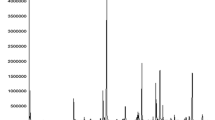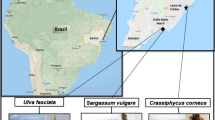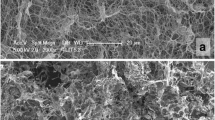Abstract
The proximate composition and mineral contents of Stichopus horrens and Holothuria arenicola from Chabahar Bay were analyzed and investigated. During the present study, we aimed to demonstrate the nutritive value. The approximate percent composition of moisture, protein, fat, and ash were 92.8, 3.47, 0.4, and 3.33% in S. horrens and 93, 4.4, 0.6, and 2% in H. arenicola, respectively. Atomic absorption spectrophotometry of the ashes indicated the body wall of two species of sea cucumbers contained higher amounts of both macro minerals (92.5 mg/100 g Mg in S. horrens and 115 mg/100 g Mg in H. arenicola; 106.25 mg/100 g Ca in S. horrens and 83.25 mg/100 g Ca in H. arenicola) and trace elements (521.781 mg/100 g Fe in S. horrens; 60.354 mg/100 g Fe in H. arenicola, and 0.096 mg/100 g Zn in S. horrens; 0.04 mg/100 g Zn in H. arenicola). For both species, there were high content of protein and essential mineral. Also, they have low content of fat in the body wall of two species in the experiment.
Similar content being viewed by others
References
Ajayi OB, Akomolafe SF, Adefioye A (2014) Proximate analysis, mineral contents, amino acid composition, anti-nutrients and phytochemical screening of Brachystegia Eurycoma harms and Pipper Guineense Schum and Thonn. American Journal of Food and Nutrition 2:11–17
Bechtel PJ, Oliveira A, Demir N, Smiley S (2013) Chemical composition of the giant red sea cucumber, Parastichopus californicus, commercially harvested in Alaska. Food Science & Nutrition 1:63–73
Belitz H (2001) GWSP. Lehrbuch der Lebensmittelchemie. Berlin, Heidelberg, New York: Springer Verlag
Bligh EG, Dyer WJ (1959) A rapid method of total lipid extraction and purification. Can J Biochem Physiol 37:911–917
Chang-Lee MV, Price RJ, Lampila LE (1989) Effect of processing on proximate composition and mineral content of sea cucumbers (Parastichopus spp.) J Food Sci 54:567–568
Conand C (1990) The fishery resources of Pacific island countries: holothurians vol 272. Food & Agriculture Org.
Frazier WC, Freizer D, Westhoff D (1978) Food microbiology
Gornall AG, Bardawill CJ, David MM (1949) Determination of serum proteins by means of the biuret reaction. J Biol Chem 177:751–766
Haki G, Rakshit S (2003) Developments in industrially important thermostable enzymes: a review. Bioresour Technol 89:17–34
Halstead BW (1965) Poisonous and venomous marine animals of the world. Vol. I. Invertebrates Poisonous and venomous marine animals of the world Vol I Invertebrates
Hamel J-F, Conand C, Pawson DL, Mercier A (2001) The sea cucumber Holothuria scabra (Holothuroidea: Echinodermata): its biology and exploitation as beche-de-mer. Adv mar Biol 41:129–223
Hanif R, Iqbal Z, Iqbal M, Hanif S, Rasheed M (2006) Use of vegetables as nutritional food: role in human health. Journal of Agricultural and Biological Science 1:18–20
Iqbal A, Khalil IA, Ateeq N, Khan MS (2006) Nutritional quality of important food legumes. Food Chem 97:331–335
Isaac IO, Ekpa OD (2009) Minerals and anti-nutrients in two varieties of African pear (Dacryodes edulis). J Food Technol 7:106–110
James D (1989) Beche-de-mer: its resources, fishery and industry. Mar Fish Inf Serv Tech Ext Ser 92:2–30
Ladan M, Bilbis L, Lawal M (1996) Nutrient composition of some green leafy vegetables consumed in Sokoto. Niger J Basic Appl Sci 5:39–44
Liu Z, Oliveira AC, Su Y-C (2009) Purification and characterization of pepsin-solubilized collagen from skin and connective tissue of giant red sea cucumber (Parastichopus californicus). J Agric Food Chem 58:1270–1274
Mottet MG (1976) The fishery biology and market preparation of sea cucumbers. Washington Department of Fisheries
Nnamani C, Oselebe H, Agbatutu A (2009) Assessment of nutritional values of three underutilized indigenous leafy vegetables of Ebonyi State, Nigeria. Afr J Biotechnol 8:2321
Omotoso O (2006) Nutritional quality, functional properties and anti-nutrient compositions of the larva of Cirina forda (Westwood)(Lepidoptera: Saturniidae). Journal of Zhejiang University-Science B 7:51–55
Salarzadeh A, Afkhami M, Bastami KD, Ehsanpour M, Khazaali A, Mokhleci A (2012) Proximate composition of two sea cucumber species Holothuria pavra and Holothuria arenicola in Persian Gulf. Annals of Biological Research 3:1305–1311
Salunkhe DK, Deshpande S (2012) Foods of plant origin: production, technology, and human nutrition. Springer Science & Business Media
Sidwell VD (1981) Chemical and nutritional composition of finfishes, whales, crustaceans, mollusks, and their products
Sikorski Z, Kolakowska A, 孫寶年, Pan BS (1990) The Nutritive Composition of the Major Groups of Marine Food Organisms (Chaper 3) Seafood: Resources
Smiley S (1994) Holothuroidea. Microscopic Anatomy of Invertebrates 14:401–471
Smirnov A, Gebruk A, Galkin S, Shank T (2000) New species of holothurian (Echinodermata: Holothuroidea) from hydrothermal vent habitats. J mar Biol Assoc UK 80:321–328
Soetan K, Olaiya C, Oyewole O (2010) The importance of mineral elements for humans, domestic animals and plants—a review. Afr J Food Sci 4:200–222
Tanikawa E (1955) Studies on the protein of the meat of sea cucumber (Stichopus japonicus), Hokaido: Memoar of the Facualety of Fisheries of Hokaido University. No3
United States Department of Health E, Welfare National Institute of Arthritis M, Diseases D, Food Policy A.O.o.t.U.N.F. et al (1972) Food composition table for use in East Asia: U.S. Department of Health, Education, and Welfare
Wang F (1997) Nutrient analysis of frozen sea cucumber (Acaudina molpadioides). East China Sea Marine Science 15:65–67
Windom H, Stein D, Scheldon R, Smith JR (1987) Comparison of trace metal concentrations in muscle of a benthopelagic fish Coryphaenoides armatus from the Atlantic and Pacific oceans. Deep Sea Res 34:213–220
Zhong Y, Khan MA, Shahidi F (2007) Compositional characteristics and antioxidant properties of fresh and processed sea cucumber (Cucumaria frondosa). J Agric Food Chem 55:1188–1192
Author information
Authors and Affiliations
Corresponding author
Additional information
Responsible editor: Philippe Garrigues
Rights and permissions
About this article
Cite this article
Barzkar, N., Attaran Fariman, G. & Taheri, A. Proximate composition and mineral contents in the body wall of two species of sea cucumber from Oman Sea. Environ Sci Pollut Res 24, 18907–18911 (2017). https://doi.org/10.1007/s11356-017-9379-5
Received:
Accepted:
Published:
Issue Date:
DOI: https://doi.org/10.1007/s11356-017-9379-5




